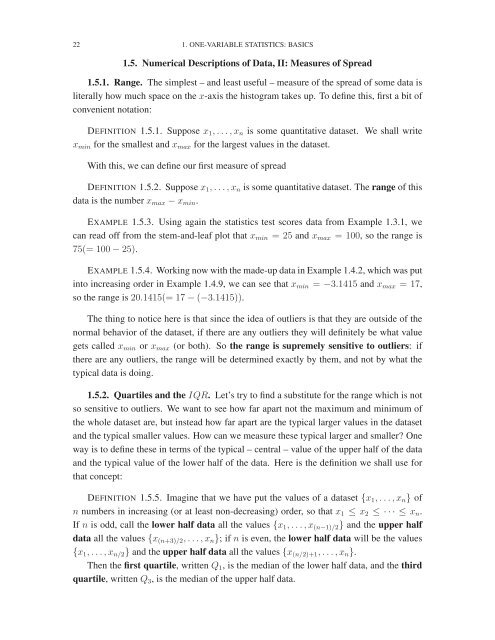Lies, Damned Lies, or Statistics- How to Tell the Truth with Statistics, 2017a
Lies, Damned Lies, or Statistics- How to Tell the Truth with Statistics, 2017a
Lies, Damned Lies, or Statistics- How to Tell the Truth with Statistics, 2017a
You also want an ePaper? Increase the reach of your titles
YUMPU automatically turns print PDFs into web optimized ePapers that Google loves.
22 1. ONE-VARIABLE STATISTICS: BASICS<br />
1.5. Numerical Descriptions of Data, II: Measures of Spread<br />
1.5.1. Range. The simplest – and least useful – measure of <strong>the</strong> spread of some data is<br />
literally how much space on <strong>the</strong> x-axis <strong>the</strong> his<strong>to</strong>gram takes up. To define this, first a bit of<br />
convenient notation:<br />
DEFINITION 1.5.1. Suppose x 1 ,...,x n is some quantitative dataset. We shall write<br />
x min f<strong>or</strong> <strong>the</strong> smallest and x max f<strong>or</strong> <strong>the</strong> largest values in <strong>the</strong> dataset.<br />
With this, we can define our first measure of spread<br />
DEFINITION 1.5.2. Suppose x 1 ,...,x n is some quantitative dataset. The range of this<br />
data is <strong>the</strong> number x max − x min .<br />
EXAMPLE 1.5.3. Using again <strong>the</strong> statistics test sc<strong>or</strong>es data from Example 1.3.1, we<br />
can read off from <strong>the</strong> stem-and-leaf plot that x min =25and x max = 100, so <strong>the</strong> range is<br />
75(= 100 − 25).<br />
EXAMPLE 1.5.4. W<strong>or</strong>king now <strong>with</strong> <strong>the</strong> made-up data in Example 1.4.2, which was put<br />
in<strong>to</strong> increasing <strong>or</strong>der in Example 1.4.9, we can see that x min = −3.1415 and x max =17,<br />
so <strong>the</strong> range is 20.1415(= 17 − (−3.1415)).<br />
The thing <strong>to</strong> notice here is that since <strong>the</strong> idea of outliers is that <strong>the</strong>y are outside of <strong>the</strong><br />
n<strong>or</strong>mal behavi<strong>or</strong> of <strong>the</strong> dataset, if <strong>the</strong>re are any outliers <strong>the</strong>y will definitely be what value<br />
gets called x min <strong>or</strong> x max (<strong>or</strong> both). So <strong>the</strong> range is supremely sensitive <strong>to</strong> outliers: if<br />
<strong>the</strong>re are any outliers, <strong>the</strong> range will be determined exactly by <strong>the</strong>m, and not by what <strong>the</strong><br />
typical data is doing.<br />
1.5.2. Quartiles and <strong>the</strong> IQR. Let’s try <strong>to</strong> find a substitute f<strong>or</strong> <strong>the</strong> range which is not<br />
so sensitive <strong>to</strong> outliers. We want <strong>to</strong> see how far apart not <strong>the</strong> maximum and minimum of<br />
<strong>the</strong> whole dataset are, but instead how far apart are <strong>the</strong> typical larger values in <strong>the</strong> dataset<br />
and <strong>the</strong> typical smaller values. <strong>How</strong> can we measure <strong>the</strong>se typical larger and smaller? One<br />
way is <strong>to</strong> define <strong>the</strong>se in terms of <strong>the</strong> typical – central – value of <strong>the</strong> upper half of <strong>the</strong> data<br />
and <strong>the</strong> typical value of <strong>the</strong> lower half of <strong>the</strong> data. Here is <strong>the</strong> definition we shall use f<strong>or</strong><br />
that concept:<br />
DEFINITION 1.5.5. Imagine that we have put <strong>the</strong> values of a dataset {x 1 ,...,x n } of<br />
n numbers in increasing (<strong>or</strong> at least non-decreasing) <strong>or</strong>der, so that x 1 ≤ x 2 ≤ ··· ≤ x n .<br />
If n is odd, call <strong>the</strong> lower half data all <strong>the</strong> values {x 1 ,...,x (n−1)/2 } and <strong>the</strong> upper half<br />
data all <strong>the</strong> values {x (n+3)/2 ,...,x n };ifn is even, <strong>the</strong> lower half data will be <strong>the</strong> values<br />
{x 1 ,...,x n/2 } and <strong>the</strong> upper half data all <strong>the</strong> values {x (n/2)+1 ,...,x n }.<br />
Then <strong>the</strong> first quartile, written Q 1 , is <strong>the</strong> median of <strong>the</strong> lower half data, and <strong>the</strong> third<br />
quartile, written Q 3 , is <strong>the</strong> median of <strong>the</strong> upper half data.

















